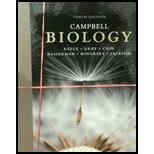
Concept explainers
WH AT IF? → Suppose two plant populations exchange pollen and seeds. In one population, individuals of geno-type AA are most common (9.000 AA. 900 Aa. 100 aa), while the opposite is true in the other population (100 AA, 900 Aa, 9.000 aa). If neither allele has a selective advantage, what will happen over time to the allele and genotype frequencies of these populations?
Want to see the full answer?
Check out a sample textbook solution
Chapter 23 Solutions
Campbell Biology & Alkaline Vents Supplemental Materials for Campbell Biology & Mastering Biology with Pearson eText -- ValuePack Access Card -- for Campbell Biology Package
Additional Science Textbook Solutions
Microbiology: An Introduction
Chemistry: Structure and Properties (2nd Edition)
Applications and Investigations in Earth Science (9th Edition)
Chemistry & Chemical Reactivity
Microbiology with Diseases by Body System (5th Edition)
Human Biology: Concepts and Current Issues (8th Edition)
- A cell expresses a transmembrane protein that is cleaved at the plasma membrane to release an extracellular fragment. The fragment binds to receptor proteins on nearby cells and activates signaling pathways resulting in altered gene expression patterns in the cells. What form of intercellular signaling does this represent? OA. Contact-dependent signaling B. Paracrine signaling OC. Synaptic signaling D. Endocrine signaling E. Autocrine signalingarrow_forwardWhich of the following drive nuclearly encoded proteins import into the mitochondrial matrix? OA. ATP hydrolysis OB. Membrane Potential OC. K+ Ions OD. A and B OE. None of the abovearrow_forwardWhich of the following statements is true regarding Cholesterol import into the cell? OA. It is transported within LDL B. Receptor mediated endocytosis is involved OC. Release of cholesterol occurs in the Lysosome D. All of the above are true statements OE. None of the above are true statementsarrow_forward
- In which of the following schematic drawings of signaling pathways does the activation of the receptor lead to gene expression? Activating and inhibitory steps are indicated with (+) and (-), respectively. OA OB ㅇㅂㅇㅂㅇㅁ (+) Gene Expression Activated Signaling proteins Transcription receptor activator Bl D Gene Expression Gene Expression ㅁㅁㅇ Gene Expression Gene Expressionarrow_forwardWhich of the following events normally activates a GTP-binding protein? OA. GTP hydrolysis by the protein OB. Activation of an upstream GTPase-activating protein OC. Activation of an upstream guanine nucleotide exchange factor OD. Phosphorylation of a bound GDP molecule by an upstream phosphorylase OE. Pi release after GTP hydrolysisarrow_forwardProteins that are synthesized on the Rough ER are imported into the ER lumen after their signal sequence is recognized. Which of the following is responsible for the signal recognition? OA. Signal Recognition Particle, OB. Signal Sequence C. Stop-transfer sequence OD. Both B and C OE. None of the abovearrow_forward
- Stroma Light 4 H 4 H I Thylakoid- membran 2 H₂O D1 D2 Min Light 2,6 ATP 2 NADP+ 2 NADPH/H+ Fp 2,6 ADP +2,6 P 8 H+ 12 H+ 4 H+ Lumen PS II Cyt bef PS I ATP-Synthase 12345 5a 5b 6arrow_forwardWhich of the following statements is TRUE regarding the signal recognition particle (SRP)? OA. SRP is made up of RNA and Proteins B. SRP binds to the signal sequence OC. SRP binds to the elongation factor binding site on the ribosome and pauses translation D. All of the above are true statements OE. None of the above are true statementsarrow_forwardWhich of the following pathways does NOT directly deliver materials to lysosomes? OA. Endocytosis B. Exocytosis OC. Phagocytosis OD. Autophagy OE. Macropinocytosisarrow_forward
- You suspect a protein to be secreted out of a cell. What experiment would you perform to follow the movement of this protein through the secretory pathway? A. Pulse - Chase Experiment OB. Signal Sequence Deletion C. Signal Sequence Mutation OD. All of the above E. None of the abovearrow_forwardA schematic drawing of the secretory and endocytic pathways is presented below. Indicate which component in the drawing (A to J) corresponds to each of the following. Your answer would be a 10-letter string composed of letters A to J only, c.g. HICDJABFGE. nuclear envelope Early endosome Late endosome ER Lysosome A ( ) cis Golgi cisterna () modial Golgi cisterna () trans Golgi cisterna [] cis Golgi network (CGN) () trans Golgi network (TGN) () Secretory Vesicle B C D E CYTOSOL F G H plasma membranearrow_forwardWhich of the following guide transport vesicles to their target membrane? A. Rab monomeric GTPases B. Signal Sequence OC. Heat Shock Proteins OD. All of the above O E. None of the abovearrow_forward
 Biology (MindTap Course List)BiologyISBN:9781337392938Author:Eldra Solomon, Charles Martin, Diana W. Martin, Linda R. BergPublisher:Cengage Learning
Biology (MindTap Course List)BiologyISBN:9781337392938Author:Eldra Solomon, Charles Martin, Diana W. Martin, Linda R. BergPublisher:Cengage Learning Biology: The Dynamic Science (MindTap Course List)BiologyISBN:9781305389892Author:Peter J. Russell, Paul E. Hertz, Beverly McMillanPublisher:Cengage Learning
Biology: The Dynamic Science (MindTap Course List)BiologyISBN:9781305389892Author:Peter J. Russell, Paul E. Hertz, Beverly McMillanPublisher:Cengage Learning Human Heredity: Principles and Issues (MindTap Co...BiologyISBN:9781305251052Author:Michael CummingsPublisher:Cengage Learning
Human Heredity: Principles and Issues (MindTap Co...BiologyISBN:9781305251052Author:Michael CummingsPublisher:Cengage Learning Biology: The Unity and Diversity of Life (MindTap...BiologyISBN:9781305073951Author:Cecie Starr, Ralph Taggart, Christine Evers, Lisa StarrPublisher:Cengage Learning
Biology: The Unity and Diversity of Life (MindTap...BiologyISBN:9781305073951Author:Cecie Starr, Ralph Taggart, Christine Evers, Lisa StarrPublisher:Cengage Learning Biology 2eBiologyISBN:9781947172517Author:Matthew Douglas, Jung Choi, Mary Ann ClarkPublisher:OpenStax
Biology 2eBiologyISBN:9781947172517Author:Matthew Douglas, Jung Choi, Mary Ann ClarkPublisher:OpenStax





